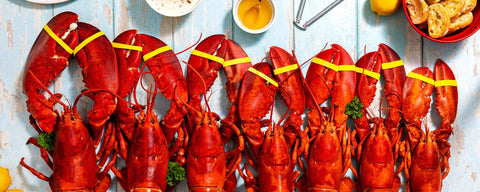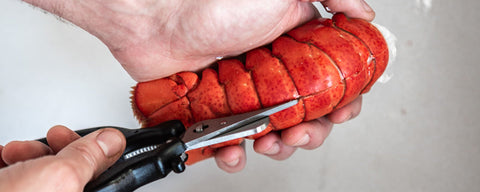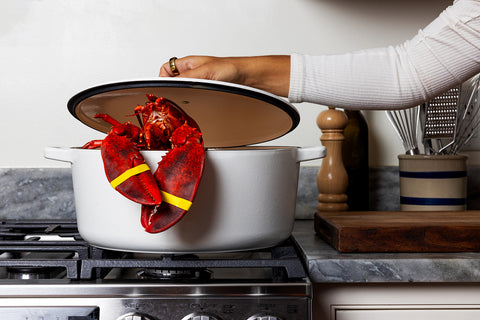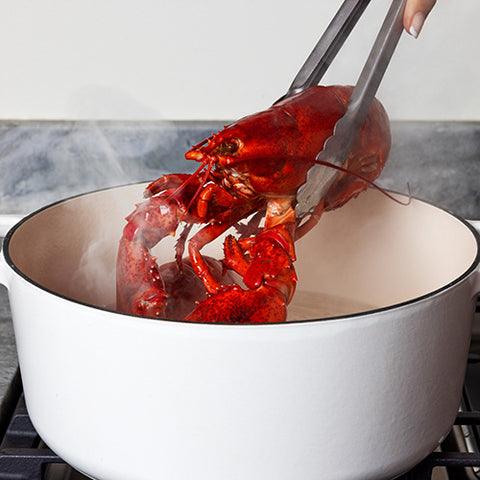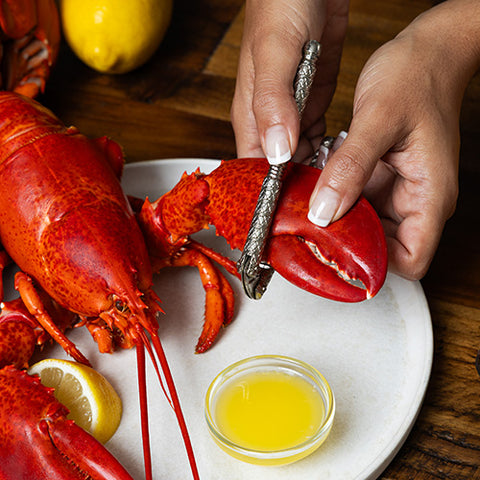How To Cook Live Lobsters
Many individuals who try to cook live lobsters don't know how to do so properly. Ever since Maine Lobster Now™ first opened its doors, our customers have been asking us how they can steam, grill or boil their live lobsters to perfection. Our large inventory of jumbo and regular lobsters is the perfect place to start searching for the perfect Maine lobster. We also offer scrumptious lobster dinner side dishes to complement your meals. Once you have live lobster, keep reading to learn everything you need to know about how to cook it.
How To Store Live Lobsters Until Cooking
Proper lobster storage is crucial because it prevents the meat from spoiling. Lobster meat is no longer edible if the lobster dies before you cook it. Moisture and temperature are the main factors to consider when keeping lobsters alive.
Lobster Storage Do's
- Put the entire box in the refrigerator or walk-in cooler. If there isn't room, then you can replace the frozen gel packs and keep the box in a cool place. Another good option is to store the lobsters your refrigerator door with the seaweed we include.
- Please take your time choosing your delivery date, since lobsters should be cooked the same day that you receive them.
- Use the same saltwater seaweed or soaked newspaper to keep them damp.
- The ideal storage temperature is 40 degrees Fahrenheit.
- For extra storage time, we recommend purchasing extra seaweed.
Lobster Storage Don'ts
- Avoid putting ice on the lobsters or storing them in a bathtub, as freshwater kills them.
- Keep your box out of sunlight.
- Do not discard a black or brown lobster! Lobsters are naturally brown or black. It is common to expect lobsters to arrive red, but they don’t. They turn red while cooking. A live lobster's shade or darkness depends on the season you purchase it and the last time it molted.
Compare A Live vs Cooked Lobster
See the difference in color? Don't throw out a brown lobster!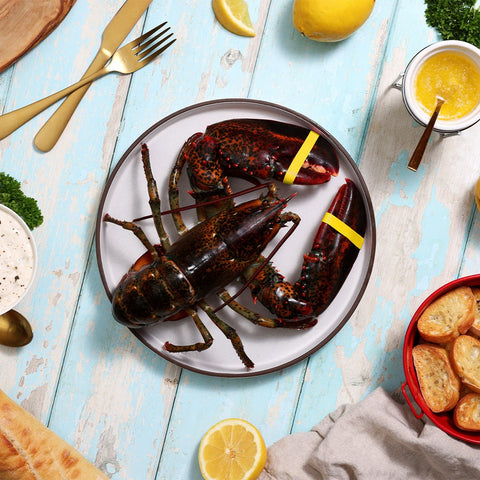
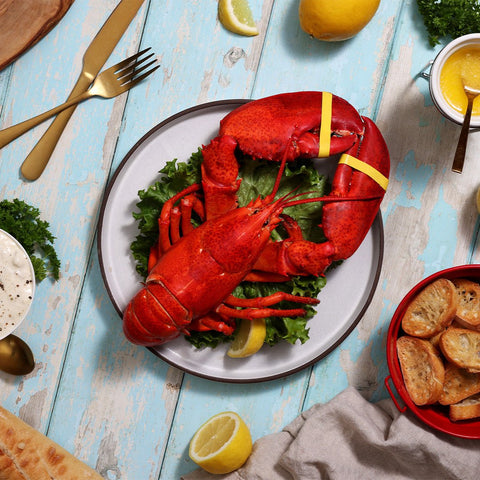
Why Use Seaweed to Store Lobsters?
Seaweed or wet newspaper is the best way to store live lobsters for several reasons. Lobsters breathe through their gills, so keeping them wet helps them stay alive. Seaweed is particularly effective because it’s moist and salty like their natural environment.
It’s essential that you don’t store live lobsters in freshwater — or even salt water that you’ve made with freshwater. The water that comes from your tap has chlorine in it and will kill your lobsters.
What Size Lobster Should I Buy?
If you have to store lobsters for more than 24 hours, we recommend a 2-pound lobster or larger — the larger, the better. These larger lobsters hold their temperature and moisture better than smaller lobsters because of their thicker shell. In some wholesale shipments, select sizes (2 pounds and larger) will actually live over 48 hours in transit, so 24 hours is a pretty safe bet if stored properly for these sizes.
At Maine Lobster Now, we guarantee all lobsters will be alive upon arrival. However, lobsters must be stored properly after that or they’ll die and become unfit to eat!
Getting Ready To Cook — Things You Should Know Before You Start Cooking Lobsters
Do you know how to cook lobster until it’s tender, juicy and not overdone? Cooked lobster is incredible and a perfect crowd-pleaser. However, cooking lobster isn’t intuitive and requires several steps for best results.
How to Cool Cooked Lobster
Cooling your lobsters after steaming or boiling is essential to avoid overcooking them. People often turn the stove off but leave steaming lobsters in the pot. However, they’ll continue to cook if left hot and may be ruined.
A good way to prevent overcooking is to spray cooked lobsters with your sink's hose or an outdoor hose. Spraying them with cold, fresh water after they finish cooking helps them remain in the perfect serving condition. Turning off the fire isn’t enough, and leaving them in a hot pot filled with steam will cause them to keep cooking. Spraying them with cold water is the best option.
What Tools Do You Need to Cook Lobster?
If you have a regularly stocked kitchen, you can cook lobster. However, there are some specific items that can make cooking lobster much easier and faster. Here’s a quick list of kitchen tools to have on hand when you’re cooking lobster:
- Large pot
- Tongs or heat-safe gloves
- Rubber bands for the claws
- Kitchen knife
- Lobster crackers
- Bowl to collect meat
- Plate for shells
As you cook lobster, you’ll get a feel for the tools you most enjoy using. Some people buy cracking tools designed for lobster, while others repurpose nutcrackers or a mallet. Although tongs aren’t a must, they’re very helpful for handling the hot lobsters without getting burned.
What Sized Lobster Pot?
It's important to choose a pot that has plenty of room. If the pot is too full, the heat won’t circulate evenly. If you have a small pot, you can cook the lobsters in several batches. For a few small lobsters, a 4 or 5 quart pot will work well. Larger lobsters, around 1.5 pounds, will fit well in a 20-quart pot. Although you might want to reach for a heavy-duty pot, water will boil faster inside a thinner metal. Using an inexpensive aluminum pot outside is a good choice because a burner can scorch the pot.
How To Tell If a Lobster Is Spoiled
- Your lobsters should look alive with tails straight and claws up. Even if your lobster seems cold, the legs underneath their body should move a little.
- If you have a lobster that isn't moving, set it on its back and wait. If it doesn't start to move in a few minutes, it's dead. You shouldn’t cook dead lobster, so let us know as soon as you discover the loss. If one of your lobsters is dead, please take a picture of it on its back and email customer service for a refund. Including an invoice number will expedite the refund process.
Killing a Live Lobster Humanely
Many people find it uncomfortable to kill a creature, but following our directions is a very humane way to cook lobsters. In the wild, lobsters are often caught and eaten by a range of sea creatures, including seals, crabs and even eels.
By contrast, many people choose to painlessly put lobsters to sleep before eating them at home. This is an easy process, and you won’t have to worry about the lobsters being in pain while you cook them. Cooking live lobsters doesn’t actually mean you cook them while they’re alive.
Putting Lobsters to Sleep
- Before cooking live lobsters, place them in a freezer for approximately 10 to 20 minutes. The cold will put them to sleep so they don’t feel the heat or any pain when you boil them.
- Once they’ve been frozen, you can take the bands off their claws.
- To butterfly a lobster tail, first you’ll separate the tail so you can cook it separately. Pull the tail apart from the center or cut with a knife. The claws would cook about the same time as the normal cook time of the live lobster.
- If you plan on butterflying a lobster tail, you will need seafood shears to cut the lobster tail.
Do Lobsters Scream When You Put Them in Boiling Water?
No, absolutely not. Lobsters do not “scream” because they have no lungs, throat or vocal cords. If you hear a high-pitched noise from the cooking pot, it’s because the lobster shell traps and releases air. When you apply heat, the trapped air expands and escapes through small gaps, producing a high-pitched sound similar to when you use your mouth to whistle.
Boiling Live Lobsters
If you’ve never cooked lobsters before, boiling is a good method to try. It’s the perfect way to get that delicious saltwater flavor in the cooked meat. Because the lobsters are cooked in water this way, they stay tender and don’t dry out.
At Maine Lobsters Now, we actually have an industrial-style cooker and boil 100 pounds of lobsters at a time! Trust our 30 years of experience — boiling is the best way to cook lobsters. You can follow our simple instructions for deliciously boiled lobster.
Instructions for Boiling Live Lobsters:
- Fill a large pot with approximately three water quarts for every 1.5 pounds of live lobster. You should completely submerge each lobster in water.
- Add 1/4 cup of Maine Sea Salt to every four quarts or one gallon. The sea salt gives the lobsters an excellent flavor.
- Heat the salt water until it reaches a rolling boil.
- Add each lobster to the pot individually with tongs or gloves, and leave the pot uncovered.
- When they’re halfway done, give the lobsters a stir. Refer to the proper cooking times listed below.
- Lobsters turn bright red when they are done boiling.
- Place the cooked lobsters in cold or cool water, or place them on a plate for three to five minutes before serving.

Instructions for Boiling Live Jumbo Lobsters:
- Fill a large pot with water, cover it with a lid and let it reach a rolling boil. Improve the cooking flavor by adding salt.
- Place the lid on the pot and continue cooking until the tail's internal temperature reaches 170 degrees Fahrenheit. Place a digital thermometer's probe in the top of the tail's soft membrane to check its temperature. Ensure you insert the thermometer into the meat for an accurate reading, not between the shell and the meat.
- Check the claws' temperatures after the tail reaches 170 degrees because a larger lobster's claws require a longer cooking time than its tail. Insert the thermometer probe above the top of the claw, through the soft membrane and into the meat. Check both claws since they differ in size, and remember that larger lobster claws require more cooking time. Separating the tail from the claws after it reaches 170 degrees and continuing to cook the claws separately is the best way to ensure they also reach 170 degrees. Refer to the chart below for additional boiling time information.
- Submerge the lobsters in ice or ice water after it cooks fully.
- A jumbo lobster's shells are significantly harder than small lobsters' shells, so you will most likely need to crack its claws using a mallet or hammer.

How To Steam a Whole Lobster at Home
Steaming lobsters is the most traditional method because it results in an excellent meal. There are several benefits to steaming lobsters, including:
- They cook faster because you can cook them at 165 degrees Fahrenheit
- You don’t have to wait until the water boils
- You can add various seafood or seaweed for more food
Find our instructions for steaming live lobsters below. Like boiling, steaming lobsters helps them to retain moisture. However, you have to keep them covered and watch carefully to ensure you don’t overcook them and dry them out.
Instructions for Steaming Live Lobsters:
- Pour approximately 2 inches of water into your pot, and add Maine sea salt if you use freshwater.
- Place seaweed in the pot if you wish.
- Wait for the water to reach a heavy boil.
- Place your live lobsters in the pot with tongs or gloves, and cover the pot tightly.
- Reduce the heat to a rolling boil after it starts to boil heavily again, and start your timer.
- Steam the first pound of lobsters for nine minutes and an additional four minutes per each extra pound. Refer to the steaming times listed below.
- The steamed lobsters will turn a bright red shade when they finish cooking.
- Once they’re done, remove them carefully with gloves or tongs. Place them in cool water or place them on a plate for three to five minutes so they can cool.

How To Grill Live Lobsters
Grilling lobster adds a delicious char flavor to the meat that you can’t replicate with boiling or steaming. If you consider yourself a grill master and love the flavor you find on the grill, you should definitely try this method!
The challenging part of grilling lobster is ensuring all parts of the lobster cook completely. To help with this, you can cut your lobsters in half so the center cooks thoroughly. Because it’s so much easier, cutting lobsters is common when grilling.
Like with other cooking methods, it’s always better to undercook rather than overcook lobster on the grill. Scorched lobster is not very good. Sometimes, it can be tough to find an exact cooking time for lobsters because of variations in size and shape. When in doubt, shorten your cooking time and check the meat's temperature.
Below are specific instructions on how to grill lobster:
Instructions for Grilling Live Lobsters:
- Combine salt, pepper, olive oil and lemon juice to create a marinade.
- Use a knife to sever the lobster's head at the base of its neck and remove each claw arm.
- Twist the tail to remove it.
- Add the tomalley and coral to the marinade after mashing them.
- Discard the legs and carapace.
- Cut the tail's underside lengthwise with scissors. Remove the tail meat after cracking the upper shell, and skewer the tail meat to ensure it remains flat.
- Let the meat marinate for two to three hours.
- Place the tail meat and claws on your grill approximately 4 to 5 inches over the flame.
- Baste the lobster tail meat while it's cooking in the marinade.
- Grill the lobster meat for five to six minutes.
- Flip and baste the tail and claw meat. After basting, cook it for an additional five minutes.
- Lobsters turn bright red when they are done grilling.
Lobster Cracking Instructions:
- Twist off the lobster claws.
- Crack each lobster claw and knuckle with a lobster cracker.
- Separate the lobster tail from the body.
- Insert a fork and push the tail meat out in one piece.
- Remove the black vein which runs the length of the lobster tail.
- Extract the meat from the legs by biting down and squeezing the meat out with your teeth.
- Use your fork to find the meat in the lobster's tail flippers.

